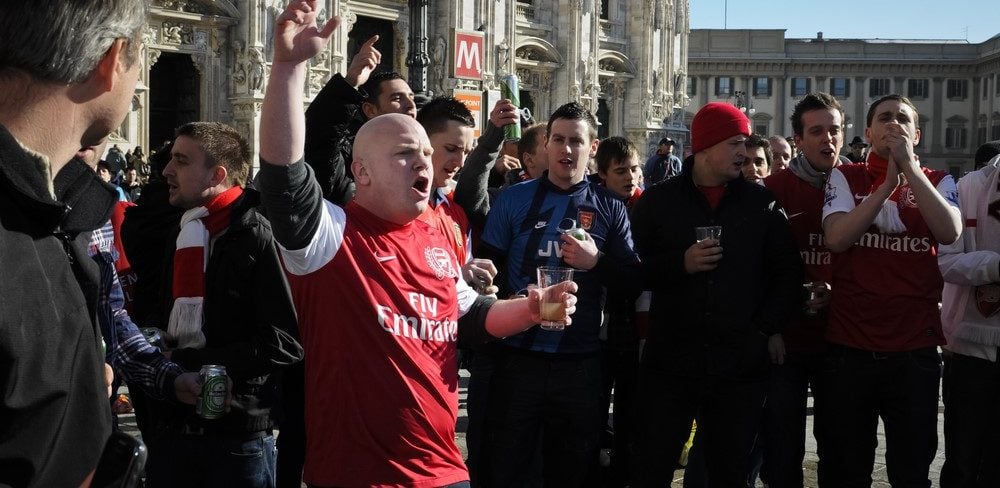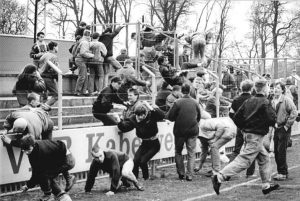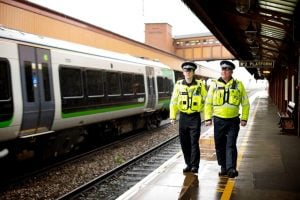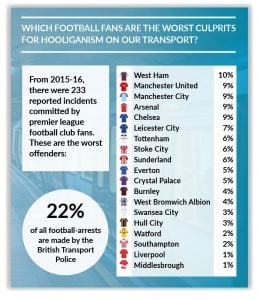From 201516, crime on the railway has increased for the first time in 10 years, by 4%; the equivalent of 2,030 offences. The British Transport Police (BTP) has also seen a consistent rise in football-related incidents since 2012. Unfortunately, football has always had an association with violence, disorder and intimidation. For many rail commuters, this makes match days a living nightmare where large groups of chiefly male supporters invade train and tube stations, emitting a slew of chants and disrupting public order.
The History of Hooliganism
Photo credit: Wiki Commons / Ralf Pätzold
Hooliganism blighted the beautiful game during the 1970’s and 80s. Incidents such as the 1985 Heysel Stadium disaster, when 39 Juventus fans died during the European Cup Final against Liverpool after hostility between the opposing supporters, remains a prevalent memory for the general public. Although yobbish behaviour may have reached its height at the end of the 20th century, rowdy football fans have been recorded since the 1880’s (then nicknamed ‘roughs’.)
By 1997, it was said by Reuters that the English game had “virtually rid itself of the hooligan scourge”. However, with the invention of social media, hooliganism has returned to the 21st century with fervour. Today, in contrast to the spontaneous upsurges of violence of the past, fans of rival teams use the internet to arrange pre-agreed locations before and after matches to fight the opposition.
Why are Hooligans targeting our railways?
Picture credit: Flickr / West Midlands Police
A statistical news release from the Home Office indicates that the overall number of football-related arrests over the last five football seasons has decreased. However, football-related arrests made by the British Transport Police is on the rise for the fourth year running. The three most common football-related offences are public disorder (60%), alcohol offences (20%) and violent disorder (16%).
Among all football-related arrests during the 2015-16 season, more than 2 in 10 (22%) arrests were made by the British Transport Police. During Premier League matches this figure increases dramatically for public disorder arrests; 33% of which are made by the BTP.
According to a 2015-16 Freedom of Information request into football-related incidents on British railways, one of the reported offences included “4-500 fans who boarded a special train service. While at platform the doors of the train were forced open and coins thrown at rival fans. Due to the difficulty closing doors, the train lost power, causing one cancellation and delays to 15 trains. [A] train window was later found to have been smashed.”
Incidents like the one mentioned above demonstrate the destructive nature of football hooliganism, with one BTP report from 2013 stating one particular incident had cost more than £3000 in damages.
Furthermore, when searching for key terms in the reports, words such as ‘sexual’, ‘sexist’ and ‘racist’ were prominent, further highlighting the vitriolic nature of many acts of hooliganism. One report emphasised the issue of sexism, stating that a “female informant reported a group of 10 males [who] were wolf whistling, lifting female’s skirts and grabbing the backsides of female passengers as they walked by.”
So why does hooliganism persist on the railways? Oftentimes, the trains are the first encounter between rivalling fans having been segregated in the stadium. Add to this the fact that alcohol is often consumed in large quantities before a match (as it is banned in the stadium) and you are left with a dangerous mix of tension and intoxication.
British Transport Police (BTP) chief constable Paul Crowther said in 2015 that the number of incidents on the transport network may be even higher, because victims feel too frightened to talk to British Transport Police officials.
Which fans are the worst culprits for hooliganism on our transport?
Looking at the reported incidents during the 2015-2016 football season, there were 233 incidents where a premier league football team was mentioned as being the club supported by the offender. Here are the percentages of those incidents committed by football team:
What measures are the BTP taking?
Photo credit: shutterstock / Keith Gentry
Much like Margaret Thatcher’s ‘war cabinet’ against football hooliganism, and ‘stiff’ sentencing for yobs, the BTP are cracking down on what was once dubbed ‘The English disease’. The BTP, who police more than 8.6 million passenger journeys a day, held a football conference in 2015 on the matter. The conference was the first of its kind and attended by colleagues from MPS, representatives of the football industry, and transport providers, to discuss the issue of anti-social behaviour related to football.
On this matter, the British Transport Police stated the following, “We adopt a proactive approach to football policing, with officers escorting trains before and after matches and patrolling stations where large numbers of fans are expected.”
Furthermore, on public disorder, the BTP relayed that “this concerted effort to identify instances of disorder, particularly lower levels of antisocial behaviour, has this year resulted in a 40% increase in these types of offences compared with the previous season.”
The BTP added that “fixed penalty notices are not used for football-related offences, making sure that offenders are charged with the most serious offences their conduct warrants.”
FEATURE IMAGE: Photo Credit: Eugenio Marongiu / Shutterstock






